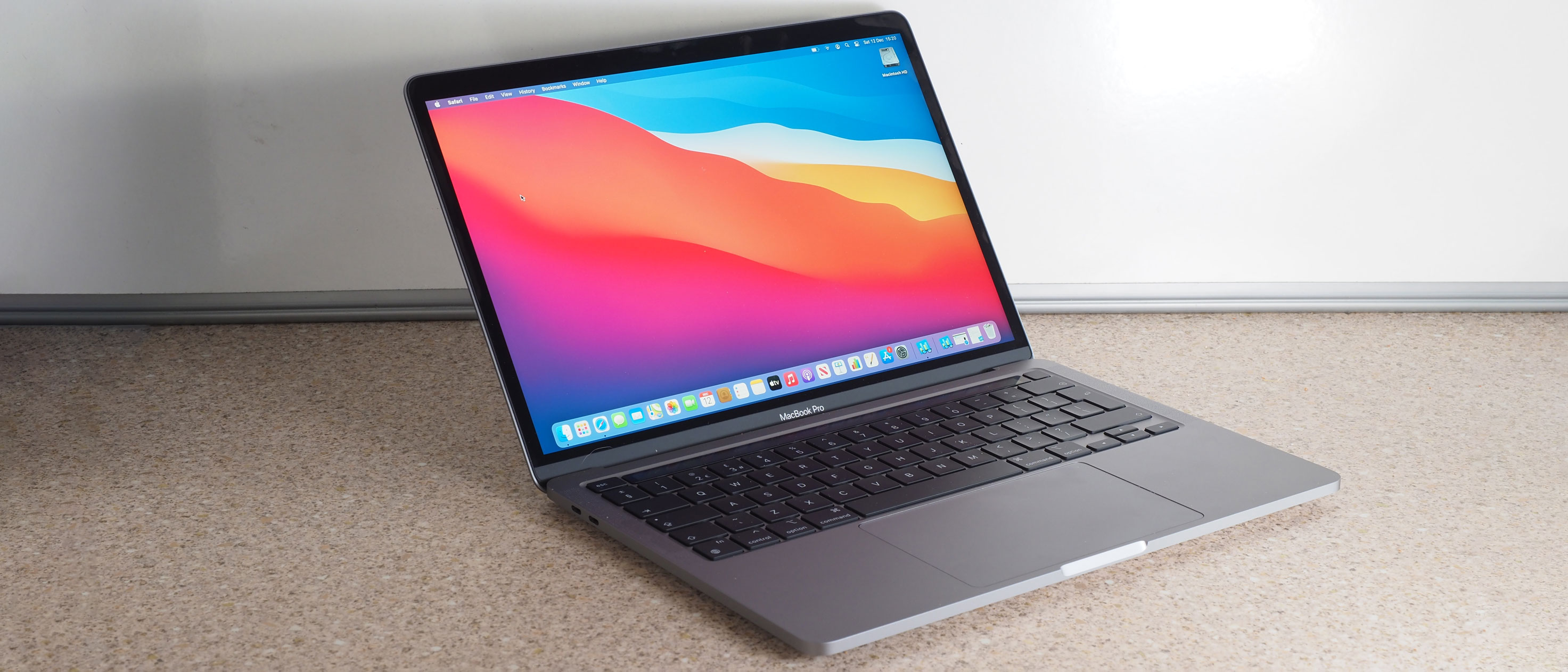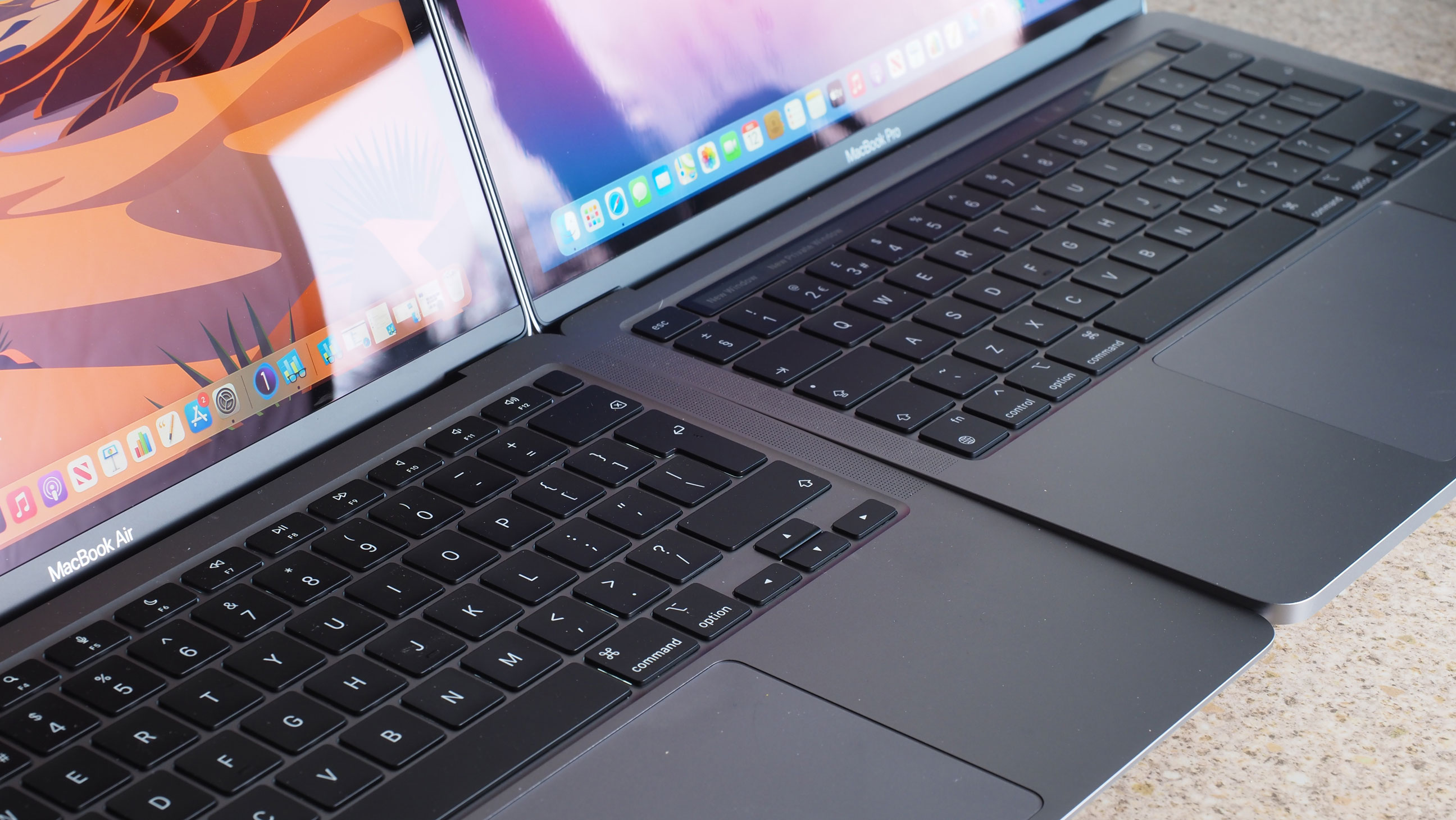Digital Camera World Verdict
The MacBook Pro 13-inch M1 is not cheap for a laptop, obviously, but if you need a certain level of performance for your photo or video editing, then a cheap laptop is never going to provide it. In fact, this M1-powered MacBook gives you a very good level of performance for your outlay, even leaving aside its excellent Retina screen, backlit keyboard and handy touchbar. We think Apple might just have nailed it.
Pros
- +
Surprisingly useful Touch Bar
- +
Excellent Retina display
- +
Weight, size, design, keyboard…
Cons
- -
16:10 screen, which annoys us for some reason
- -
No HDMI port or memory card slot
Why you can trust Digital Camera World
The MacBook Pro 13-inch M1 is one of a new generation of Apple computers. Apple has started the switch from its previous Intel processors to its own brand new M1 chip, and this is one of the first models to get it.
The M1 processor is Apple’s first chip designed specifically for the Mac. Its claim to fame is its integrated system on a chip (SoC) design, which combines the CPU, GPU (graphics processor), Apple’s Neural Engine and more into a single chip. Apple is claiming stellar performance and energy saving benefits, and while other models will continue with Intel for now, most new Mac buyers will probably see the M1 chip as the future.
For now, just three Mac models have this M1 processor: this one, the MacBook Air 13-inch M1 and the Mac Mini M1.
• See also: Best monitors for MacBook Pro
Specifications
Processor: Apple M1 8-core
Graphics: 8-core GPU
Neural Engine: 16-core
RAM: 8GB (configurable to 16GB)
Screen: 13.3-in LED IPS, 2560 x 1600
Storage: 256GB SSD (configurable to 2TB)
Connectivity: 2x USB 4/Thunderbolt, headphone socket, WiFi, Bluetooth
Battery life: 17hrs (wireless Internet)/20hrs (movie playback)
Dimensions: 304.1 x 212.4 x 156mmWeight: 1.4kg
Key features
The MacBook Pro 13-inch M1 has a lot in common with the MacBook Air 13-inch M1. No, really, A LOT. Both use an 8-core Apple M1 chip with 8GB RAM expandable to 16GB, they have the same 13.3-in LED IPS, 2560 x 1600 Retina display and the same 256GB base level SSD drive.
Where they differ is that the MacBook Pro has a different physical design, with a uniform flat profile rather than the ‘wedge’ shape of the Air. It also starts with an 8-core GPU, where that’s a more expensive option for the base level Air which, oddly, has a 7-core GPU.
The best camera deals, reviews, product advice, and unmissable photography news, direct to your inbox!
The MacBook Pro also uses active fan cooling for heavy processing tasks, while the Air is fan-less, which may result in the processor being throttled back when under heavy load.
Connectivity is limited to a pair of Thunderbolt/USB 4 ports and a headphone jack. Yes, that really is it. You can connect a monitor and a charger at the same time, but that’s your lot.
Build and handling
Our review machine came with Apple’s Space Grey finish, but it’s also available in regular Silver. There’s not much to be said about Apple’s finish and build quality that hasn’t been said before, but the MacBook Pro’s satin-finish casing is almost a work of art in itself.
The keys on the ’scissor’ keyboard have a light feel but a short and positive action, and the keyboard is quiet, too, which is often appreciated in public places.
The trackpad is a really good size to accommodate the numerous and useful gestures in Mac OS and the touchbar, which seemed a bit of a novelty when we first saw it, is actually rather useful. For those who don’t know, it’s a touch-sensitive strip at the top of the keyboard which displays relevant controls for whatever app you’re using, and acts like virtual keys and sliders.
Perhaps the star of the show for us, though, is the 2560 x 1600 13-inch Retina display. The pixel pitch is so fine that you just don’t see the dots. This does actually change the way you view and work with images and video. In a bizarre way it stops you being a pixel peeper, because you can see if an image is sharp or not without needing to zoom in.
Performance
| Header Cell - Column 0 | MacBook Air 13-inch M1 | MacBook Pro 13-inch M1 | 2013 MacBook Pro 13-inch |
|---|---|---|---|
| Single-core CPU score | 1722 | 1728 | 401 |
| Multi-core CPU score | 7547 | 7590 | 1114 |
| OpenCL GPU score | 15967 | 19148 | 3162 |
| Metal GPU score | 17953 | 21352 | 422 |
We used GeekBench 5 to test the MacBook Air’s multi-core and single-core processing performance, and its GPU performance for OpenCL and Apple’s own Metal graphics processing. We compared the MacBook Pro 13-inch M1 against the MacBook Air M1 and a 2013 MacBook Pro as a reference to see how far things have come.
The results are impressive. The MacBook Pro and Air deliver similar CPU speeds, but the Pro is ahead in GPU performance, probably by virtue of having 8 cores to the Air’s 7 cores – and for intensive video or 3D rendering, the gap is likely to widen as the Pro’s in-built fans will let the processor run at full speed for longer.
Also interesting is the difference between the new M1 Pro and our 2013 model. If you secretly wondered whether MacBook speeds have really evolved all that much… well, they have, and how!
Performance is affected by other factors, of course, notably drive and bus speeds – the greatest speed gains come from using SSDs and USB C/Thunderbolt for external drives. Some applications seem to provide their own bottlenecks, just doing things in their own sweet time, so fast as they are, the new Macs still won’t make Lightroom, Capture One or DxO PhotoLab load in the half a second you might have been hoping for.
Verdict
The MacBook Pro 13-inch M1 is a star performer. You can get (much) cheaper laptops than this but they will be (much) slower. Apple has a reputation for overcharging customers for ‘design’, but this MacBook Pro does seem pretty good value. You get excellent design and finish (but NO HDMI port or memory card slot – grr), a superb screen and a super-fast processor.
It’s not a cheap option, but photographers and videographers need a certain baseline performance specification, and that inevitably costs more. In performance alone, the MacBook Pro 13-inch M1 actually looks quite cost effective, and you have to factor in the superb screen and equally superb finish too.
Read more:
• Best photo editing laptops
• Best laptops for video editing
• Best portable hard drives
• Best portable SSDs
• Best monitors for photo editing
• Best portable monitors
• Best laptop stands

Rod is an independent photography journalist and editor, and a long-standing Digital Camera World contributor, having previously worked as DCW's Group Reviews editor. Before that he has been technique editor on N-Photo, Head of Testing for the photography division and Camera Channel editor on TechRadar, as well as contributing to many other publications. He has been writing about photography technique, photo editing and digital cameras since they first appeared, and before that began his career writing about film photography. He has used and reviewed practically every interchangeable lens camera launched in the past 20 years, from entry-level DSLRs to medium format cameras, together with lenses, tripods, gimbals, light meters, camera bags and more. Rod has his own camera gear blog at fotovolo.com but also writes about photo-editing applications and techniques at lifeafterphotoshop.com




